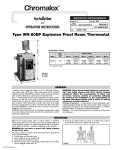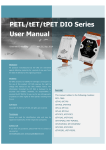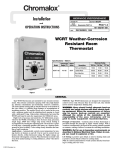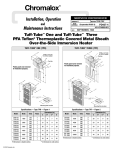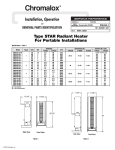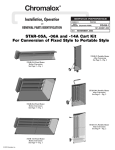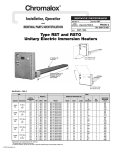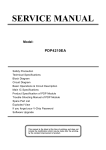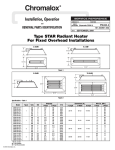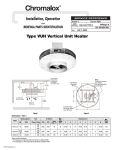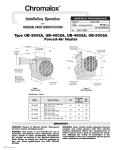Download Chromalox PD441-1 User's Manual
Transcript
® Chromalox Installation, Operation SERVICE REFERENCE DIVISION and 4 SALES REFERENCE MAINTENANCE INSTRUCTIONS SECTION MTO-LT PD441-1 (Supersedes PD441) 161-303567-001 DATE MARCH, 1999 Type MTO-LT Pipe Insert Immersion Heater A Expansion Gap B 2-3/8” Max. Spacer 2-1/16” I.D. Min. Type E2 Moisture-Tight Explosion-Resistant Enclosure Pipe, Support & Tank (by others) Expansion Gap 3/4” Pipe Outlet GENERAL Model kW Volts Phase MTO-241LT MTO-241LT MTO-251LT MTO-251LT MTO-275LT MTO-275LT MTO-212LT MTO-213LT 4 4 5 5 7.5 7.5 11.5 13 240 480 240 480 240 480 480 480 1 1 1 1 1 1 1 1 Dim. (In.) A B 127 127 163 163 211 211 319 367 120 120 156 156 204 204 312 360 Pipe Thd. 2 2 2 2 2 2 2 2 WARNING: Calculate and allow for thermal expansion. Pipe insert will expand upon heating. The rear end of the pipe insert must remain free from the tank wall. Heating elements will also expand upon heating and must not extend to the end of the pipe insert. Chromalox type MTO-LT screwplug immersion heater is designed for insertion into a 2” or larger pipe. WARNING: It is the responsibility of the purchaser of the heater to make the ultimate choice of pipe material based upon his knowledge of the chemical composition of the corrosive solution, character of the material entering the solution and controls which he maintains on the process. Chromalox cannot warrant any electric immersion heater against failure, if such failure is the result of corrosion due to improper material selection by the user. 1. Heater Construction Characteristics: A. High quality resistance wire held in place by compacted Magnesium Oxide Refractory enclosed in an Incoloy® sheath. B. Low to High Watt densities. C. Explosion Resistant/Liquid-Tight E-2 terminal enclosures are standard. WARNING: Users should install adequate controls and safety devices with their electric heating equipment. Where the consequences of failure may be severe, backup controls are essential. Although the safety of the installation is the responsibility of the user, Chromalox will assist in identifying equipment options. INSTALLATION WARNING: Hazard of Shock. Disconnect all power before installing heater. 1. Before installing, check your type MTO-LT pipe insert heater for any damage that may have occurred during shipment. 2. Check to insure that the line voltage is the same as that stamped on the nameplate. 3. Do not bend the heating elements. If bending is necessary, consult factory. 4. IMPORTANT: Mount heater in the tank so that the liquid level will always be above the effective heated portion of the heater (see Figure 1). If the heater is not properly submerged, it may overheat and damage the heating elements and create a possible fire hazard due to excessive sheath temperatures. 5. Where work will pass over or near equipment, additional protection such as a metal guard may be needed. © 2010 Chromalox, Inc. Expected Low Level of Liquid This Portion of Heater Above Liquid Level and Exposed to Air Will Lead to Premature Burnout of Element WRONG RIGHT Expected Maximum Sediment Level Note: Locate Heater as low as possible for maximum liquid storage capacity. Heat does not move downward. Figure 1 - Open Tank Installation INSTALLATION 6. Heater must not be operated in sludge. 7. Install the heater using a high quality pipe sealing compound on the threads. Screw the heater into the opening (Figure 2). Tighten sufficiently with wrench applied on the hex portion of the screwplug. 2” Approx. 6” Cold place. A2. Position outlet and inlet in a vertical plane, facing upward to prevent air pockets. Be sure all trapped air is removed from the closed tank. Bleed the air out of the liquid piping system and heater housing prior to operation. A3. IMPORTANT: Heater should never be located at the highest point in the system. Provide expansion tank, if necessary. B. Vertical Position (Figure 4) 9. DANGER: Hazard of Fire — Since the heaters are Drip Loop Recommended to Minimize Passage of Moisture Along Wiring Into Terminal Wiring and Connections Outlet Suitable Wiring Inlet WARNING: Care must be taken to insure the heated portion does not extend into the coupling area (see Dimensions). Figure 2 - Exploded View Pipe Insert Heater Mounting Locate Drain Pipe at Bottom of Heater. Sediment Deposits may be Removed Through Drain Pipe 8. Closed Tank Installation NOTE: When heating in closed vessels, controls and back-up controls must be used to prevent buildup of temperature and/or pressure. A. Horizontal Position (Figure 3) Figure 4 - Closed Tank in Vertical Position capable of developing high temperatures, extreme care should be taken to: A. Avoid contact between heaters and combustible materials. B. Keep combustible materials far enough away to be free of the effects of high temperatures. Note: In a Forced Circulation System, Use Pump In Inlet Side Outlet Maximum Sediment Level. Install Heater Above This Level But as Near to it as Possible for Maximum Heated Solution Storage Capacity Inlet Heater Figure 3 - Closed Tank in Horizontal Position A1. Place heater at an elevation so that natural circulation can take WIRING WARNING: Hazard of Shock. Any installation involving electric heaters must be effectively grounded in accordance with the National Electrical Code. 1. Electric wiring to heater must be installed in accordance with the National Electrical Code and with local codes by a qualified person as defined in the NEC. WARNING: Use copper conductors only. 2. When element wattages are not equal, heaters must not be connected in series. 3. Electrical wiring to heater should be contained in rigid conduit or in sealed flexible hose to keep corrosive vapors and liquids out of the terminal housing. 4. If flexible cord is employed, a watertight connector should be used for entry of the cord into the terminal box. Outdoor applications require liquid-tight conduit and connectors. 5. Bring the power line wires through the opening in the terminal box. Connect line wires as shown in the wiring diagram (see Figure 5). L-1 L-2 240-480V — Figure 5 OPERATION 1. Do not operate heaters at voltages in excess of that stamped on the heater since excess voltage will shorten heater life. 2. Always maintain a minimum of 2” of liquid above the heater to prevent exposure of the effective heated length. If the heater is not properly submerged, it may overheat and shorten heater life. DO NOT OPERATE HEATER IF TANK IS DRY. 3. Be sure all trapped air is removed from a closed tank. Bleed the air out of the liquid piping system and heater housing prior to energizing. Note: The tank or heating chamber in closed tank systems must be kept filled with liquid at all times. 4. Keep heating elements above sediment deposits. 5. Low Megohm Condition — The refractory materials used in electric heaters may absorb moisture during transit or when sub- ject to a humid environment. This moisture absorption results in a cold insulation resistance of less than twenty megohms. Normally, this megohm value corrects itself after heatup and does not affect heater efficiency or life. A low megohm condition can easily be corrected by removing the terminal hardware and terminal enclosure and baking the heater in an oven at 350˚F for several hours, preferably overnight. Note: The lid must be removed from the housing. An alternate procedure is to energize the heaters at low voltage until the megohm reading returns to normal. When energizing heaters in air, the sheath temperature should not exceed 750˚F. MAINTENANCE WARNING: Hazard of Shock. Disconnect all power to heater before servicing or replacing heaters. 1. Heaters should be checked periodically for coatings and corrosion and cleaned if necessary. 2. The tank should be checked regularly for sediment around the heater pipe insert as sediment can act as an insulator and shorten heater life. 3. Remove any accumulated sludge deposits from around pipe and from tank. 4. Check for loose terminal connections and tighten if necessary. 5. If corrosion is indicated in the terminal housing, check terminal box gasket and replace if necessary. Check conduit layout to correct conditions that allow corrosion to enter the terminal housing. 6. Clean terminal ends of all contamination. Limited Warranty: Please refer to the Chromalox limited warranty applicable to this product at http://www.chromalox.com/customer-service/policies/termsofsale.aspx. 2150 N. RULON WHITE BLVD., OGDEN, UT 84404 Phone: 1-800-368-2493 www.chromalox.com TA - Q0 - EF Litho in U.S.A.




